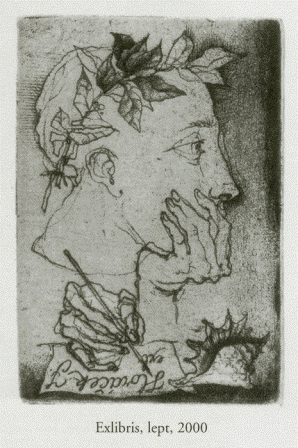 Seven years with Marina
were not just about bookplates
BOHUMIL CHALUPNÍČEK
Seven years with Marina
were not just about bookplates
BOHUMIL CHALUPNÍČEK
Work and its transformation, continual pursuance, successes, ovations and incomprehensible disappointments with the feeling of revolt against injustice, emotions from break-ups and reunions, surprises and changes of any kind, opposition and total mutual devotion – this is how I perceive last seven years experienced by Marina Richter.
An author, graphic designer, illustrator and graduate from the Academy of Arts, Architecture and Design in Prague. From my point of view, she has unambiguously achieved the highest level on the Czech graphic scene which is, though, hard to define. From this advantageous position, she literally impacts it in an adrenalin way. However, she is considered a greater, calmer and constantly developing star in the European countries and overseas. By mere chance, her seven years affected my most interesting period in my life so far in which we are having breakfasts together. I had known her a long time before. But in a completely different way. She used to attend my lectures on perspective and display methods at the above mentioned academy.
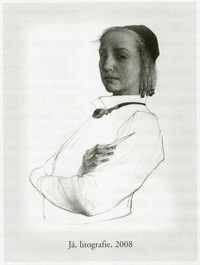 I was happy when I could ask her to come to the blackboard, full of perspective constructions, and I liked looking at her guilelessly. I was there when she graduated, pregnant at that time, and I didn´t have the slightest idea that the problems - always arising in adolescence - would be harsh for us both. My signature of the first “post velvet revolution” AAAD vice- president is in her academy diploma. Now, she doesn´t even know where she had put it.
I was happy when I could ask her to come to the blackboard, full of perspective constructions, and I liked looking at her guilelessly. I was there when she graduated, pregnant at that time, and I didn´t have the slightest idea that the problems - always arising in adolescence - would be harsh for us both. My signature of the first “post velvet revolution” AAAD vice- president is in her academy diploma. Now, she doesn´t even know where she had put it.
We haven´t known about each other for the long period of sixteen years, but not completely…
In her second year of studies she brought me, as all students did, a “sketch” that fully reflected her Russian soul – it was a façade of an antique temple by which she wanted to please me. There were fluted columns, one of which was knocked down and a drapery was thrown over it. Although I didn´t tell her anything at that time, I was deeply excited about her work. I didn´t know what to think about it. It was so different from the work of other students; among the bad ones which were not worth attention at all, certainly, and masses of color and linear expressions it was extremely shy and dignified at the same time. I had always paid attention to the role she chose freely and she was always part of my exhibitions where I presented my results as a teacher. Nowadays, after the seven years with Marina I see everything kind of symbolic.
I can ask myself a very simple question: how many of those artists are on the same level as Marina...
Writing these words bears accidental, maybe fatal elements. By the very first inevitable touch, everything started to develop more than forty years ago. At that time, my father – an architect working also at the AAAD – worked on a number of special preparatory documentations for important buildings. One of the investor representatives was an engineer called Milan Humplík who was, thanks to this, respected in our family. The crucial time of cooperation between him and my father was from first half of 1960´s to mid 1970´s. I remember this time very well when I “had to” help my parents with the commission. Deadlines were usually not met and I - with my teenage naivety - conveyed Mr Humplík various most absurd reasons why such things had happened.
In the new century I met Mr Humplík again. I met him as an erudite connoisseur and collector of graphics. I wasn´t surprised by that at all. I dare to say that Marina is one of the best top graphic designers and what is more, she has been so good for a long time. He has collected her early work for many years, including her later and contemporary work. In this year it will have been 15 years since he asked her for a bookplate. A print called “The last song of Pied Piper” was Marina´s first commission in such a sphere of art and, when taking into account the big number of ex libris in her repertoire, it might be perceived a significant landmark. In spite of all these facts, these two extraordinary people do not “agree on” a lot of things. Nevertheless, Mr Humplík is a well balanced, tactful and sociable man, so he can make any discrepant edges blunt.
The fact that three strangely connected and intertwined people, including me, met, a long time ago, in times when Marina was born, couldn´t remain without an outcome – he kindly asked me to write this article. To find a solution to his general concept was for me a professional as well as a personal challenge. More so when it is published in such an elegant journal edited by Milan Humplík.


 King Lear, a selection from Marina` s theses at AAAD, soft cover, 1990
King Lear, a selection from Marina` s theses at AAAD, soft cover, 1990
I have read all the articles published about Marina in various newspapers and journals. Many of them could not help but write about the melodrama logically inspired by the untypical story of her life which cannot be strictly separated from her work. In articles which she could influence by an interview, I could read about injustice, revolt, struggle and other confrontations. It is necessary to admit that in a number of cases the shifts and changes in her work are caused by her feelings and emotional character.
The first and foremost feeling was resistance against being considered a part of the crowd. She did not want to fit in the role of a Russian woman carrying, with love, pride and publicity, the cross of her pain of life. Especially in her puberty it used to be a national symbol imbedded deeply in tradition. Having been untouched by difficulties of life, she gathered all her courage and left with a “stranger” to the unknown. It was the unknown which she considered a quality in comparison to what she had known very well. After a long starting period it did not look good at all, however, her first steps in a new land brought about an incredible fulfillment of her destiny.
Marina graduated from the Art and Craft College in Moscow, and she finished her first year at the Stroganov Institute. So, at that time she could have been accepted and transferred to a similar university in the Czech Republic. With her husband they found out that there are options to study either at the Academy of Fine Arts located in Letná or at the Academy of Arts, Architecture and Design. She chose the latter since the school was on the underground line A which was easier to reach, and the transfer from Russian to Czech AAAD could be remarkably speeded up.

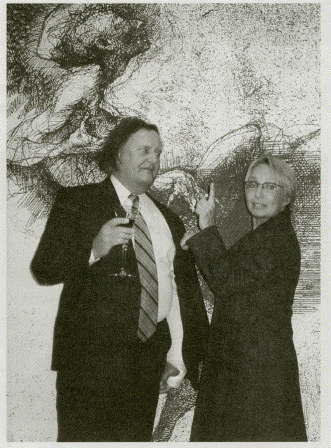
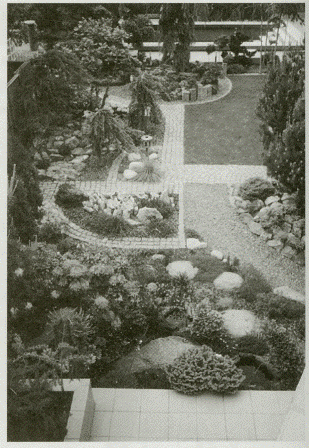 Foto:
Foto:
Nothing was that easy, anyway. The consultation board deciding about her transfer could see Marina only as a college graduate. Quite unbelievably for the Soviet period and the Moscow College, a big importance was attributed to the concept of an icon. The curricula of this undoubtedly interesting college included also craft techniques which had been considered the highest level of conservation work. The board was thinking about the need to “level her studies” by studying our Czechoslovak college. Finally, the transfer to the AAAD Special Studio of Illustration and Graphics was successful. I think that this targeted coincidence was one of the lucky ones. At that time, Prague AAAD could offer Marina a larger “playfield” for her work, though with strict limits and barriers which surrounded us all.
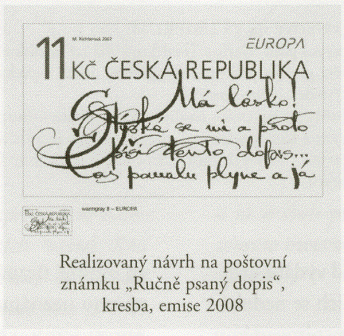
In a number of AAAD studios, study was nearly a walk through a rose garden; but by far not for Marina. She struggled with poverty, literally with bare existence, and fought against radical refusal of her new relatives. Since being a Russian lady in former Czechoslovakia occupied by Russians, it was not easy for her not even among her peers. She could not understand the concept of collective blame, and so far she has not taken a stand. Following a fierce conflict the other day, it is the kind of issue we do not open up anymore. Marina did not guess which context she was coming to. The orthodox cross round her neck as a symbol of her stay in the „democratic western-like Czechoslovakia” and her liberal behavior was often wildly discussed by the contemporary school management.
Her initial inability to speak and understand Czech together with similarities between Russian and Czech accentuated mutual, nearly scandalous situations. Overheard Czech vulgarisms she used with utter naivety as literary language from Jungmann dictionary and she has bewildered and astonished people many times. On the contrary, Russisms have remained sporadically up to date; she sometimes says that the bus or an iron “se zlámal”, from Russian word slamális (break).
Quite a high standard of living in the family Marina got married to, compared with her personal poverty, gave rise to many conjectures. It did not fit a ready made myth and a prototype of a Soviet model student. Such an example became a nightmare for a lot of AAAD teachers, for some of them a reason to ponder and for the rest a reason to be happy about the fact that the former Soviet citizens could not be judged from black and white perspective.
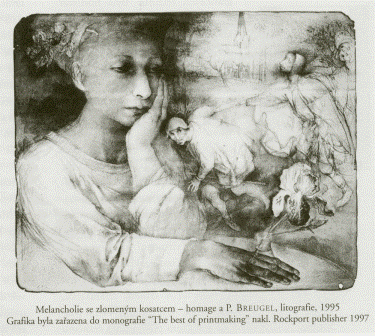
However, Marina was an exemplary student; but in a completely different way. Her personal problems were compensated by her obsession to gather knowledge and produce creative work. Together with JAN HÍSEK, she was a strong personality in their form and the others had to make a big effort to keep up with her. A number of teachers started to think highly of her and they even talked about her work in private. Marina´s work quickly started to free itself from a Byzantine inspiration and the initial influence of her father, a well-known painter OLEG FILATČEV. All these impressive and high-quality impulses could be seen only in her oil paintings from college and sometimes they – only slightly –permeated her constructive thinking and at the same time homages in her contemporary graphic art.
In last years of her studies she was gradually becoming an independent creative personality. Her professor, an academic painter called JIŘÍ MIKULA, was so horrified of Marina and mainly of the new Communist party management that instead of a woodcut cycle called Leningrad and the like he started to paint large canvases called „The End of Communism”, „Europe, Save Your Cathedrals“ and other interesting topics of his time. Not only topics but also their rendering was completely distinct and remarkable in the official context. Let us mention Marina´s credit in the change of the former AAAD president who was quite an interesting person, to pay homage to such an inspiring lady.
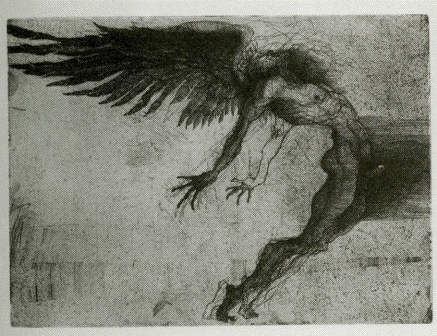

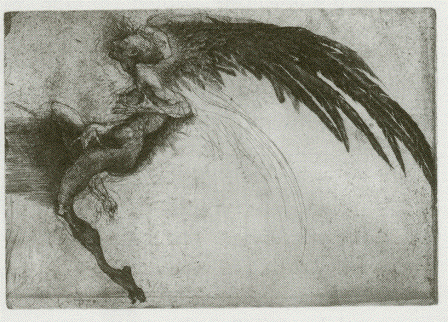 Foto:
Foto:
MARINA RICHTER produced her diploma work during the velvet revolution. Suddenly, all students, the hardworking ones as well as the less diligent, promoted the ideas of a social reform, and therefore they had less time for their work. Everything was sorted out very easily. The former teachers declared all the study results valid and thought it could have saved them. Newly accepted students were to understand the situation at school. Marina was not able to use this revolutionary holiday and worked hard on her diploma work. She created a cycle of soft covers inspired by King Lear. Pencil drawn originals are hanging in our hall and every time I come home they have double effect on me – I am confronted with their depressive mood and with its drawing and composition mastery. There are various faces, maybe ugly ones, covered under masks and anatomically incorrect tender breasts together with a devoted female face. The general impression is terror and reconciliation with fate at the same time.
Shakespeare` s book could not get a more impressive and personal visual concept. I can imagine how difficult it must have been for Marina´s new professor, JIŘÍ ŠALAMOUN, to find the understanding for her distinctive work. But he was such a professional not to interfere into it and to recommend Marina´s work for diploma defense which was recognized by the applaud and ovations of her opponent OLDŘICH KULHÁNEK .
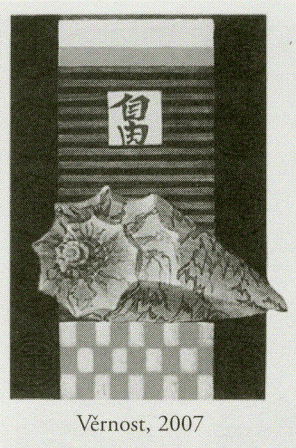
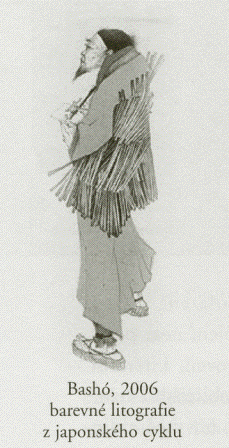
His evaluation was a perfect start of Marina´s professional career, and is worth mentioning at least in the resume of this article.
The process of making familiar with the Czech graphic design scene was a continual, emotional and predominantly targeted activity. She fully grasped all possibilities and dangers of dying reprographic techniques. She loved attending university workshops during the whole term. She made use of her right to acquire knowledge and craftsmanship. No doubt, she brought fresh wind into the workshops, which was usually characteristic only of klausura period. Not only this. Already during her studies she had mastered the means of expression characteristic of the top artists of that time. There was anything accidental in it – they devoted her time during their consultations with tutorial enthusiasm. In my opinion, it was because of her perfect ability to learn that she was often ignored by the critics. Her prints became to be comparable but completely new in everything. Marina enriched the original Czech image in her own way of thinking, concept, composition and mystery which can be revealed only after getting detailed information from the author or someone who is initiated. When I was opening one of her exhibitions some years ago I compared her work with Verdi` s librettos. The story starts a long time before the curtain rises, each part is symbolical and the meaning can be grasped only when putting puzzle pieces together. Nevertheless, the sophisticated character of work did not diminish its dynamics, composition dominance and convincing power. The main topic is always – like in music – accompanied by other tones, thus creating a symphony. I believe that in this nearly scenographic period we can see the influence of her second husband who was an actor from a family with a long acting tradition; Marina´ s high sensitivity to her surroundings, not to speak of the closest one, could not resist but to express it in her work.
In respect to Marina´s rather liberating words for me “You do not understand graphic designer´s work at all”, I can dare to say that I was happy she abandoned this genre. However, the reaction of the concerned public was embitterment and constraint. I really appreciate that Marina was able and willing to step off this track. She might have produced a number of perfect graphic pieces. A good artist always finds his or her own style that is successful with a beholder, moreover it can earn him a good sum of money. So, he or she starts to refine the style till achieving perfection. With such an aim that is sometimes really tired he or she dies as a famous person. But Marina is different. She convinced me about it by being able to resist two reaction of the public at her exhibition in South African republic. The first one including the above mentioned “Czech classic” was acclaimed and incredibly commercially successful. The second exhibition showing Marina´s new work was nearly a failure and the response to it was the following: “Mrs Richter, we want you the way you used to be”. I do not know if it did not made Marina infirm a bit, but with me appearing in her life she did not want to return to it for many other reasons.
Meanwhile she used all her abilities to play with styles of the best artists in the world. She started producing mainly small-size prints which made me worried a bit. They were various „homages” – to Lautrec and many other brilliant and commercially successful artists. At that time OLDŔICH KULHÁNEK was opening one of her exhibitions and said that MARINA RICHTER perfectly mastered and grasped individual styles of other authors. Of course, Marina perceived it as big honor but I could hear a serious warning against playing with Marina´s gift. Artists have the right to try everything. Even this interesting period was surely not isolated from other works which included book illustrations and a number of engravings motivated by “Russian theatre season in Paris – really good plays such as Fighters, I am not telling back any more etc. Art works from this period are the most interesting ones and the most frequent to be sought for by collectors.
We are not able to define strict boundaries; everything is always interconnected and mingled.
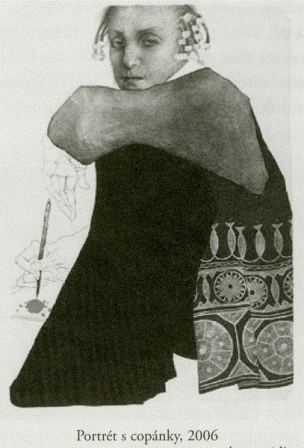
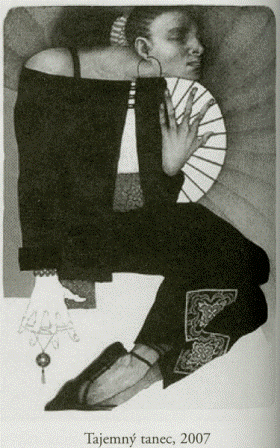
Suddenly, she started producing extremely expressive works which might have been affected by our first break-up and reunion. Marina´s prepared escape from reality in the form of a trip to Antwerp could not be canceled. At her friend Chris´s place she confined herself to a studio and started working on metal sheets. The result was her self-portrait - a rule in her figurative work - called Letter from Antwerps and mainly her two rather small size Demons. I was a little flattered by the fact that I this triptych was produced because of me. That is the reason why I was so interested in it. Having received Marina´s consent, I made an experiment: I had the small prints (having the size 20x25cm) enlarged on a large- scale Xerox two times to make it 2,5 meters. The machine, used mainly for large scale layouts and urban plans, was slowly producing a life-size figure of a Daemon respecting anatomy of a human body. This size revealed how much everything is subjected to expression, how the intentional distortions bring about tensions, sensuality and the effect of the given moment which is one of the strengths of Marina´s work. Both demons are depicted in a particular moment, in an action and with a specific expression. I was standing there in the reprographic workshop completely fascinated by the fact that each line modeling the whole volume has its precise place, certainty and sharpness, even when being enlarged ten times. So far, it has been my deepest experience with her work. With little exaggeration, I have always been saying that graphics started to take my interest in this form. The female demon is in the axis of the hallway and all our visits need us taking a picture against this background.

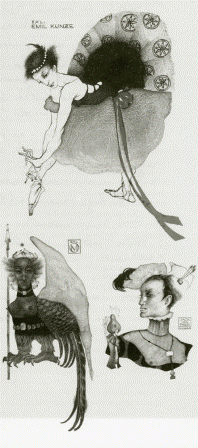
Apart from large scale works, Marina created a vast number of small scale work in which bookplates or exlibris play an important role. Was it only for them, they would still represent great creative richness. Bookplates as well as her book illustrations are hard to produce without a commission. And she really hates the business things about her work. She is totally oppressed by deadlines. She would like to work only when she feels like creating, which does not mean that she lacks inspiration. She herself says that everything is already in her head and she knows what it will look like but simply cannot make herself put the idea into action and form. I do understand her very well. I know it myself. But what she fully respects are congresses for collectors. For this occasion - when all collectors interested in her work meet - she finishes her bookplates on one stone. It is remarkable how she and the printer called PETR KORBELÁŘ can make such a difference in expression between small scale printed works. Frankly speaking, I am not able to understand, so I can only pay homage to such art.
I am looking for stories in figurative compositions; being complex and dramatic even in a very small scale, they are also highly symbolical and void of fragmented epical character. We can get the meaning thanks to the titles whose calligraphy is an integral graphical part of the composition. It is easier for me to decipher symbols in the recent non-figurative small scale engravings.
When she is working she does not exist for anybody else around her. She makes or she has a nice drink made and chooses some nice music which she plays all over and over during her long work hours. She does not eat at all and everybody else around her must fetch something on his/her own. When we are getting on well, or at the beginnings of our devotion, she wants to hear my opinions and remarks. Sometimes she listens to me fully, but mostly, I guess, she wants to check if she is going the right way, and corrects her work only slightly. Her drama of creation does not end up with a piece of stone or a sheet of metal. With the same intensity she works in printing workshops when she has her pieces printed. It does not surprise me for one simple reason – the process of creation starts on a small piece of paper: the back side of an envelope or my projects.
She produces miniatures representing scripts and motives in order to uncover everything in the material. By this, Marina honors techniques of lithography and gravure print and she makes use of them in her work. It was never about the mere preciseness when transferring her work from paper to some „technical material“. She fights like a lioness for lithography to be respected, and by her articles she literally „massages“ Japanese collectors, for example, to take the print from stone seriously and not to stick only to embarrassing admiration of gravure print. A friendship with ZDEŇĚK MÉZL - who brought her to woodcutting technique - has not resulted only in a work called Homage to Mézl but also in an interesting interview published in this journal.
In my opinion, lithography technique has played nearly a fatal role in her life. It all started with an interest in everything coming from the Far East. Japanese, Chinese and Korean artworks in fine arts, applied arts and architecture took Marina´s fancy and she started studying them eagerly. In a similar project called TAO – the Way - she studied Chinese and Korean language, the Eastern etiquette, social behavior, customs, history and culture.
She became to see the influences of the early Japan, including other cultures of the region, in everything European, especially in architecture. In Loos` s villa she found so many Japanese elements to make the renowned functionalistic building and pride of European architecture a Japanese pavilion. Only at the beginning I tried to diminish her enthusiastic discoveries because first, I wanted to avoid us having arguments, and second because she was usually right and it took me a long time to verify it. With Japanese and other Far-Eastern motives she started to experiment in her work. I was afraid that too many facts might have endangered her freedom of expression. At the same time, I was immensely impressed and touched by her motivated effort to reveal all relations to the others. But, what to do with it?
To write a book that had already been written? Or to give lectures? There was another much more interesting alternative which would have enabled Marina to combine her knowledge and her inborn emotional potential – the idea was to deal with the topic within postgraduate studies at the Academy of Arts, Architecture and Design in Prague where I work and therefore I know the relevant conditions very well. Even though my idea caused immense pain to Marina - which she has not overcome fully yet - I do not regret it. There was again a kind of revolt, action and reaction in it and it all shifted her into a new, unexpected and mature period.
Such a protest was induced by the fact that she was not accepted to the postgraduate studies. Not even in the darkest corners of my destructive fantasy would I expect it. We were only worried about Marina´s speech – about my beloved Marina´ s stammering.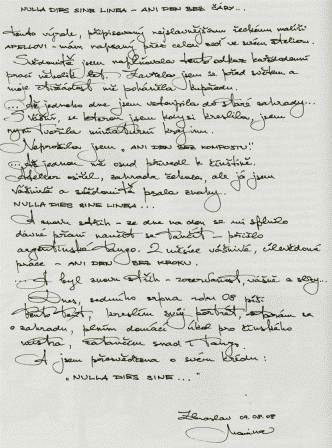 After more than two years I am starting to understand the unlucky interplay of miscomprehension and all the negatives. After all appeals submitted by Marina, my ALMA MATER, experiencing the most difficult period of total destruction, decided to repeat the entrance process and make certain changes in it.
After more than two years I am starting to understand the unlucky interplay of miscomprehension and all the negatives. After all appeals submitted by Marina, my ALMA MATER, experiencing the most difficult period of total destruction, decided to repeat the entrance process and make certain changes in it.
Marina did not bend her back, returned to her Russian fundamentals, while bearing the injustice in her life with pride and dignity and having been crowned with first big successes. In spite of all the positives caused by the AAAD refusal I feel very sorry for the situation. I feel sorry for both parties which lost a big chance to co-work on a remarkable project which would have opened an imaginary gate – MEN – to those countries. I am sorry that this door will not be open to “my” school, it could have boasted of Marina` s acquired knowledge and her collection of prints; it is also her school to which she had been accepted and which released her to the printing scene after six years.
On the other hand, I congratulate Marina that in her protest and revolt she independently created a collection of works which are far better than the ones which would have been produced in a calm and easy PhD atmosphere. The cycle with a work title Indochina is the recent “hit” in her work. Being affective in details and as a whole, it is an experimental and utterly emotive sphere for individual finesses not only on purely artistic or lithographic level. The whole cycle is subjected to the above mentioned power of the moment. Its main character – Marina, of course – is dancing, thinking, scribbling signs; but she does everything with a hidden idea, emotion and alienated moment of its capturing. Cultivated, compatible, exquisite and shocking colors play an important role. Intentionally, formats are not sufficient for Marina. The heads literally reach the upper edge of the picture and the print represents an imaginary frame of human perception. Figures reaching beyond visible field and leaving for the unknown attract beholders closely to the story which is being told. They form a part of it, while accentuating emotions.
In my opinion, particular prints from the series called Indochina cannot be considered in qualitative terms. I find some of them much more interesting than the others.
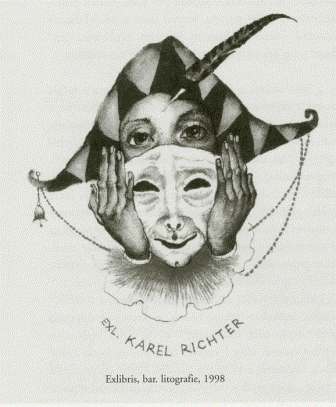 I could verify this myself when opening her exhibitions of independent works either in a gallery or on the net. The gallery owners, a married couple called JELÍNKOVI, rewarded Marina with a beautiful installation of her work in a separate room where all the walls and the vaulted ceiling were - exclusively for the purposes of this exhibition - painted dark violet. The installation inspired by the Albertina Museum in Vienna enabled the individual prints as well as the whole collection to be independently effective.
I could verify this myself when opening her exhibitions of independent works either in a gallery or on the net. The gallery owners, a married couple called JELÍNKOVI, rewarded Marina with a beautiful installation of her work in a separate room where all the walls and the vaulted ceiling were - exclusively for the purposes of this exhibition - painted dark violet. The installation inspired by the Albertina Museum in Vienna enabled the individual prints as well as the whole collection to be independently effective.
It has been a long time since Marina cannot be considered a mere graphic designer. She had started to paint and these days she might be getting back to it. She has illustrated a number of books for children and adults. Her illustrations are not always limited by the page index and independent art format. Often she continually goes across the whole book and makes it easier for the pictures to mingle with the text.
In multiple techniques, she is able to use pencil drawing which, besides watercolor, represents a very impactful and pure way of her expression. The watercolor technique itself is also admired by Marina for one simple reason – she likes blots splotched and blurred on the very right spot and in the very best color. In illustration cycles she is able to create all types of easily-remembered characters, no matter how much they change in accordance with their changing role in the story. She produced a number of interesting ceramic pieces. I believe that if she started to concentrate on this field today she would get rid of the cultivated and decorative details and I am sure that she would again create something completely new and monumental in a small scale. She is trying to grasp the word formation in eastern languages, whereas westwards it is fully absorbed by enthusiastic or tragic dance. I admire her beautifully dynamic style she applied on her first post stamp to be issued – on her handwritten letter. This print of the smallest scale was given the most logic and emotive symbolic. The meaning of the first Czech words in the stamp saying „Má lásko...“ (My love…) might be comprehensible for majority of recipients all over the Europe and the world.
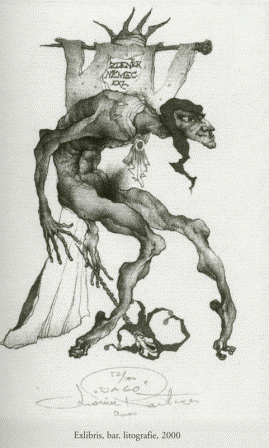
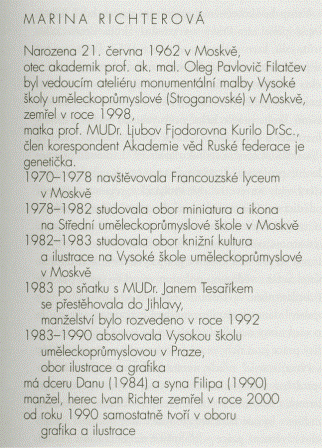
Adventure and relaxation she has found in our garden, developed on unexpected lands. We started building the garden together according to her concept. It was a beautiful, dramatic and conflicting job. We skipped the step of drafting the disputed solutions and modeled them right away in the garden. Instead of drawing lines on a sheet of paper it was necessary for us to transfer metric cents of stones. For an architect, such a demonstration of an idea is pure martyrdom and loving comprehension at the same time. It would not have worked in a different way; we would not have agreed when standing over the plan. The forms and shapes of individual pieces had conflicting empirical and geometric lines and we carefully considered the third dimension – development of individual free standing objects starts to be topical these days. The garden, being the reward of our efforts, represents the result of Marina` s enthusiastic creative work with living material. She has the feeling for volumes, appropriate material and colors applied in the whole space and its separate “saloons”.
Moreover, she enriched the garden in her concept of temporality, and with her valuable experience gathered after many years, she grows temporarily blooming plants in separate and cascaded parts of our garden in order to avoid empty spaces there. All our visitors are astonished by the garden Marina entered some time ago with her enthusiastic creative energy. She follows the general interior concept of our house adjoining an open glass wall.
The interior and the garden are linked by the same material, pavement, metal constructions, lights and colors. It is a space for living, relaxation and hard work and it is our common studio. Every evening we feed our fish swimming under the lotuses and other water plants. We watch their nearly human faces. We communicate with them in an indefinable way. It seems to be my deepest meditation of the day. We fully understand Saint Anthony who preached to fish and we also admire a Renaissance philosopher and translator Ovidius Petar Hektorovič who had his ideas chiseled into the stone plates round the pool with fish at his seat Starigrad in Hvar. We have never skipped visiting his house. Respecting the dignity of fish we realize it and we take is as historical symbols. I understand Marina` s way of thinking that is so close to her concept of the Far East. I understand our mutual harmony and break-ups which are genuine. Her personality is mysterious and easy to decipher only for somebody. She finished one of her interviews by saying that she would like to die in the arms of a loving person. I would not wish anything else for her. Only the fate will decide if her wish is fulfilled or not.
She has experienced true love and utter malediction. When pursuing her ever- changing aim she walks along a prickly and thorny way.
MARINA RICHTEROVÁ
Born 21st June 1962 in Moscow,
Her father was an academic painter and a professor Oleg Pavlovič Filatov; he headed the Studio of Monumental Painting at Academy of Arts and Crafts (Stroganov) in Moscow; he died 1998,
Her mother was Ljubov Fjodorovna Kurilo DrSC, a doctor, genetic and a female member of Academy of Science.
1970–1978 Marina attended French lyceum in Moscow
1978–1982 Marina studied miniature and icon at College of Arts and Crafts in Moscow
1982–1983 Marina studied book culture and illustration at Academy of Arts and Crafts in Moscow
1983 after getting married to a doctor Jan Tesařík, Marina moved to Jihlava; the couple got divorced in 1992
1983–1990 Marina attended Academy of Arts, Architecture and Design in Prague, namely Studio of Illustration and Graphics
She has a daughter called Dana (born 1984) and a son called Filip (1990)
Her husband Ivan Richter, an actor, died in 2000
From 1990 she has been working independently on prints and illustrations
Doc. ak.arch. Bohumil Chalupníček
Architekt, pedagog Vysoké školy uměleckoprůmyslové v Praze
